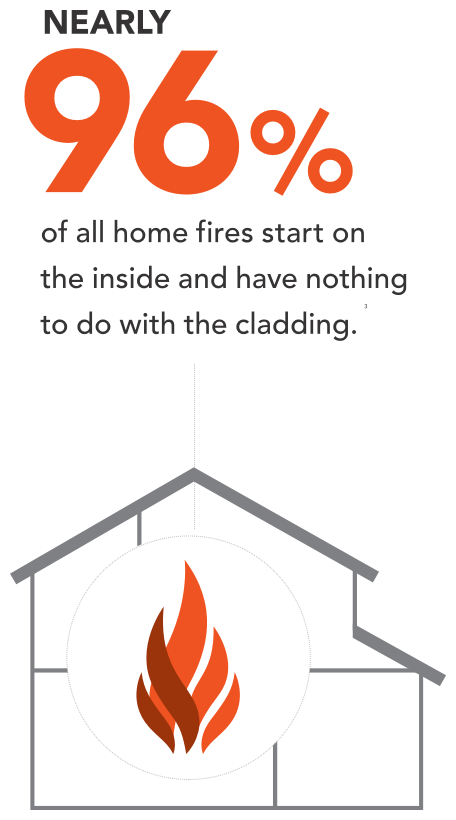Understanding the Fire Performance Benefits of Polymeric Cladding
Meet or Exceed the Industry Standards for Safety
According to the U.S. Census Bureau,* vinyl siding is the most popular choice for exterior cladding in residential homes in the Midwest and New England.
For years, polymeric products have been a recognized material that meet or exceed building codes and industry standards for safety.
Approved for use in all types of construction, including:
- Non combustible rated structures up to 40 feet
- One-hour fire-rated assemblies
- Wildfire zones
- Other fire-resistive construction
The VSI Product Certification Program includes requirements for fire testing. Certified insulated vinyl siding (ASTM D7793) and polypropylene siding (ASTM D7254) are tested in accordance with ASTM E84 for surface flame spread per the ASTM product standard requirements. Optional E84 fire testing is available for vinyl siding (ASTM D3679), and all claddings recognized in the program can also be certified to ASTM E119 and NFPA 268. Fire testing information is included in every published PCL and PER for the applicable product type.
* 2019 American Housing Survey
Harder to Ignite, Easier to Extinguish
All organic materials — i.e., anything containing carbon — will ignite.
But materials with higher ignition temperatures are naturally safer.
Ignition Points:

Residential Fires: What to Know
Exterior cladding is involved in only a small fraction of all house fires. Most residential fires begin inside the home and are contained within the structure of origin.
According to a report from the National Fire Protection Association (NFPA), fewer than 3% of all fires go beyond the source inside residential structures and fewer than 2% of these occurrences are related to the exterior wall surface. Less than 4% of all residential fires start outside the structure and do not necessarily originate with the exterior cladding.1
PVC Slows Flames from Spreading
PVC, the primary ingredient in vinyl siding, doesn’t release a lot of energy when it burns and will not readily spread flames on its own.2 Vinyl siding also needs unusually high amounts of oxygen to burn and stay burning, so it extinguishes more easily.
Plus, when any organic material burns, it releases smoke that contains many different combustion products — including toxic gases. There is no research to substantiate claims that vinyl materials release unusually toxic combustion products.3
- National Fire Protection Association Fire Analysis and Research Division, Home Structures Fires, November 2020
- Results of ASTM E162-06 test, Standard Test Method for Surface Flammability of Materials Using a Radiant Heat Energy Source
- Fire Properties of Polyvinyl Chloride, Vinyl Institute, 2017

International Wildland-urban Interface Code
Polymeric cladding is allowed for use under this code in all conditions with certain performance requirements.
Chapter 5 of the IWUIC breaks down various risk types for developments relative to wildfire and then places certain materials requirements. Three different types of risk categories impact the type of Ignition Resistant (IR) wall construction requirement.
In the most stringent IR wall construction (IR1 and IR2), according to Sections 504 and 505, polymeric cladding may be used so long as it is a part of a 1-hour E119-rated assembly and exhibits a flame spread index no greater than 25. When an IR3 condition applies, there are no requirements or limitations on a specific wall construction or cladding type.


